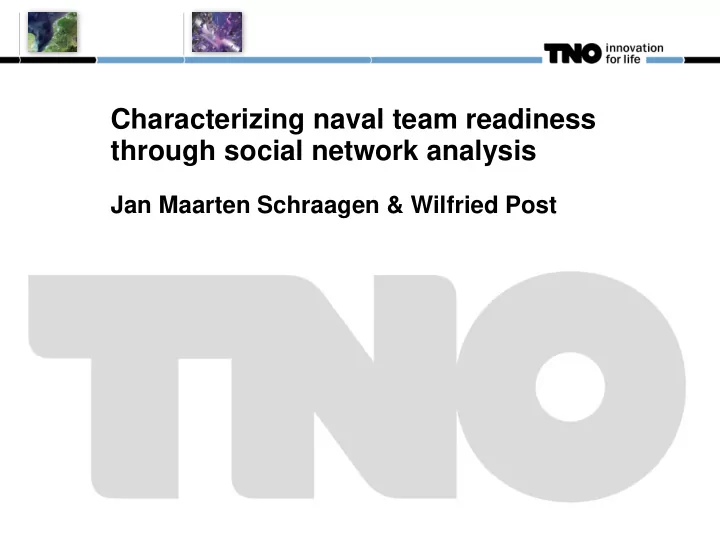

Characterizing naval team readiness through social network analysis Jan Maarten Schraagen & Wilfried Post
Overview Team performance measurement Social network analysis Case study in naval teamwork Conclusions, lessons learned and recommendations
Team performance measurement Huge progress made over the past decades (e.g., Brannick, Salas, & Prince, 1997; Flin, O’Connor, & Crighton, 2008) Current team performance measurement characterized by: Need for experienced raters Need for multiple raters Need for well-calibrated raters Use of abstract rating categories, not always well-understood by subject-matter experts Constructs derived from individual approach to team cognition Lack of specificity in terms of diagnosing deficiencies in teamwork
Team model 1 Team model 2 Dynamic team processes Static team entities (‘leadership’; ‘situation awareness’; ‘decision making’) Analysis at the team level Aggregation of individual knowledge Context-dependent Context-independent Better teamwork is an adaptive Better teamwork leads to team response whenever team goals effectiveness (causal I-P-O model) are jeopardized (emergent model)
Social Network Analysis Starts with sociomatrix defining which units have a ‘communicates with’ relationship (e.g., Pfautz & Pfautz, 2009; Wasserman & Faust, 1994) Study real-time team interaction at the team level (Walker et al., 2006) Advantages: Not dependent on availability of trained raters Enables precise diagnostics at specific moments in time Highly suitable for assessing teamwork within Team model 2 framework (Cooke et al., 2013)
Social Network Analysis Base unit: communication from <actor> to <actor> SNA metrics used: Degree centralization Degree centralization Eigenvector centralization Closeness centralization Density Density Betweenness centralization Hierarchy (Krackhardt) Hierarchy
Current study: naval team readiness Used Social Network Analysis techniques to study communication and coordination at the team level (ORA: Carley & Reminga, 2004) Distinguished between different levels of naval team readiness 1. ‘ unpracticed team’ 2. ‘team in training’ Research question: can we characterize naval team readiness efficiently by looking at real-time team interaction?
Method Observations of two Internal Battle coordination teams (5 officers each) Each team: Resource Manager assisted by Damage, Sewaco, Mobility, and Personnel officers Two highly demanding scenarios requiring all personnel on station and all systems available Task of IB team: build adequate damage assessment within 8 minutes
Results Network level measure Unpracticed In training Density 0.80 1.00 Betweenness centralization 0.15 0.50 Degree centralization 0.34 0.62 Eigenvector centralization 0.26 0.74 Closeness centralization 0.25 0.96 Hierarchy 0.40 0.00
Sensitivity analysis, extending to actors beyond Internal Battle team Network level measure Unpracticed In training Density 0.17 0.22 Betweenness centralization 0.16 0.07 Degree centralization 0.16 0.17 Eigenvector centralization 0.60 0.73 Closeness centralization 0.01 0.01 Hierarchy 0.61 0.60
Network structures of unpracticed team (left) versus ‘team in training’ (right)
Difference scores on node level measures for RM versus average of S-, M-, D-, and P-officers on ‘ unpracticed ’ and ‘in training’ vessels. Node level measure Unpracticed In training Degree centrality 0.25 0.46 In-degree centrality 0.20 0.46 Out-degree centrality 0.19 0.46 Eigenvector centrality 0.19 0.56
Conclusions Network level: More experienced team showed higher levels of information sharing and team member participation Node level: Resource Manager played more central role in more experienced team Resource Manager ‘in the know’, needs to advice Commanding Officer ‘Team in training’ was more ‘ready’ than ‘ unpracticed ’ team
Lessons learned (data analysis) Include core team only Restrict communication to actor-initiated communication (rather than proceduralized communication) Exclude broadcasted communication directed at groups
Recommendations and future steps SNA highly suitable for point-to-point communication May be carried out in real time, using keyword recognition Useful for debriefing teams, providing objective and to the point feedback For more information, please contact: jan_maarten.schraagen@tno.nl
Recommend
More recommend